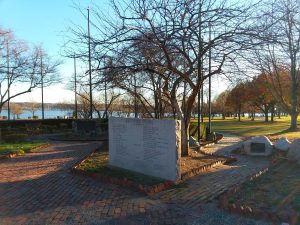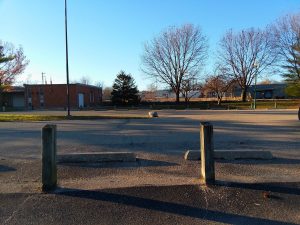Fate of Peoria’s Riverfront Park project remains uncertain
By Holly Eitenmiller For Chronicle Media — December 4, 2017
Friends of Riverfront Park is a volunteer group of concerned citizens whose goal is to prevent the construction of an apartment complex on four acres of riverfront park property. In May, the group won a Freedom of Information Act Lawsuit against the Illinois Department of Natural Resources over improperly withheld documents regarding the development. (Photo courtesy of Friends of Riverfront Park)
As the City of Peoria continues to eye a portion of Riverfront Park for an upscale apartment complex, there are many who think it would be better serve the community if built elsewhere.
For more than a decade, officials have deliberated the potential for residential development in the area that includes Constitution Garden. The city-owned four-acre plot sits at the juncture of Bond and Morton streets.
It’s a concept that gained momentum among city officials in 2015 and has since been met with considerable resident opposition.
“Urban parks are very precious things,” Friends of Riverfront Park, FORP, secretary Elaine Hopkins said. “The trees there were planted by the park district in the 1980s. There are mammals living there, groundhogs, deer. There’s a building there that was once a train station.”
There also are well-used volleyball courts, as well as a memorial to Peoria musician Dan Fogelberg, and a tidy garden area with granite monuments, brick pathways and park benches.
It is debatable as to which features would require relocation, however, developer Desmond Curran garnered land-use approval from the City of Peoria in 2015 to build River Trail Apartments, a complex of 143 upscale residences.
Curran and city officials have been met with a number of roadblocks, however, some of which threaten to undermine the project entirely.

A group of volunteers are fighting the City of Peoria to spare a portion of the city’s Riverfront Park from development. Since 2015, city officials have sought to allow developer Desmond Curran to build 143 “luxury apartments” on four acres of well-utilized park space. (Photo by Holly Eitenmiller / for Chronicle Media)
In a condition set forth by the National Park Service, the city must provide alternative park space — land that may not currently be designated as park property — as well as other requirements.
In response, the city has offered a parcel just north of Constitution Gardens at the foot of Spring Street. The property once was the home of Hawkeye Industries, a company that produced rubber products; a cause for concern of soil pollutants. It is also is flood-prone.
In a 2016 interview with WMBD News, Peoria’s Assistant City Manager Chris Setti said areas prone to flooding are the perfect location for a public park. “It allows the river to be the river,” Setti said in the interview. “Any of the design that we do for that park will take into consideration the fact that it periodically floods.”
This did not bode well with FORP or the National Park Service, which ruled in October that the “swapperty” did not meet the fair market value of the Constitution Garden plot, and stipulated the city add an additional acre to gain approval.

The northeastern landscape of Constitution Park stands in stark contrast to the stunning panoramic view of the Illinois River to its south. The City of Peoria is attempting to allow the construction of upscale apartments where much of the four-acre Riverfront Park plot is hemmed in by small industries, blighted properties and a railroad track which is used daily by Tazewell & Peoria Railroad. (Photo by Holly Eitenmiller / for Chronicle Media)
The NPS decision came in the wake of a Freedom of Information Act lawsuit filed May 15 against the Illinois Department of Natural Resources by FORP. The lawsuit contended that IDNR improperly withheld documents that would identify the legality of the sales transaction between the City of Peoria and Curran.
The documents are part of the city’s application to transfer the property to Curran, and are first reviewed by IDRN before forwarding to the NPS. Friends of Riverfront Park won and IDNR released the documents on June 22.
“We repeatedly asked IDNR for documents we need to see if the proposed sale of Riverfront Park by the city is in compliance with federal regulations. IDNR stonewalled us for three months, so we had no choice but to sue,” Hopkins wrote on her website, PeoriaStory.
Despite potential approval by the NPS, the proposal is losing momentum with some city council members.
In 2015 Fourth District Councilman Jim Montelongo favor of the project. He now has changed his stance in light of the roadblocks and delays.
Beth Akeson has opposed the project from its onset.
“My attitude was really soured from the very beginning,” said Akeson, an At-Large Councilwoman since 2011. “Primarily, I voted against it because of the way the project is sited. It’s problematic.”
However, At-Large City Councilman Zach Oyler disapproved the apartments while campaigning in 2016, but now backs it.
“I did not get access to see we were legally bound with the park service until before just before the election. The park services says they approve the use,” Oyler said. “The replacement property is better than what we have. I’m not sure what was there before. I know it’s a big section of land with a finger that goes out to the river. In my opinion, it’s much more aesthetically pleasing, now it just sits there unused and overgrown.”
Curran’s plans call for the complex and its parking areas to run parallel with the river, creating a footprint that infringes on much of the park’s amenities, she said. Also, that positioning prohibits development growth to north, in the direction of OSF St. Francis Medical Center.
A perpendicular position would not encroach as much on the park space she said, though replacing park space with residential development still does not bode well with her.
“People are averse to using parkland for private development,” Akeson explained. “I, too, was bothered by this notion that we should have private development in a public park space.”
On Dec. 12, the city council may once again vote on extending the Agreement with Curran. “It’s another chance to stop this,” Hopkins said. “If they don’t extend the agreement, it’ll be dead.”
A vacillating city council may not be the only harbinger of the end. In March, Curran announced that Indianapolis-based Herman & Kittle Properties Inc. had reneged on the plan due to its prolonged delays. And city finances play a critical role in the project.
“It’s too expensive for the city to even be fooling with, considering their $7 million deficit,” Hopkins said. “Yet, they’re fooling around with this. What if the project fails? The city has a history of failed projects. We hope the city council will see the light.”
—Fate of Peoria’s Riverfront Park project remains uncertain–







